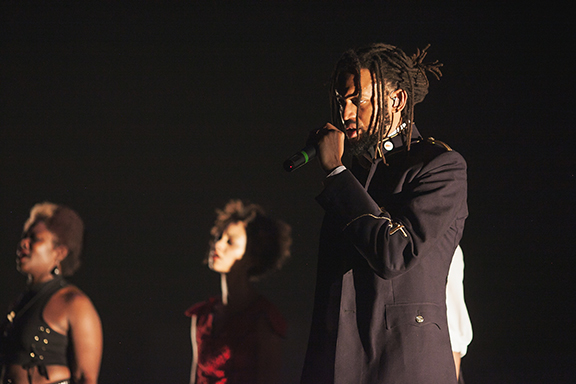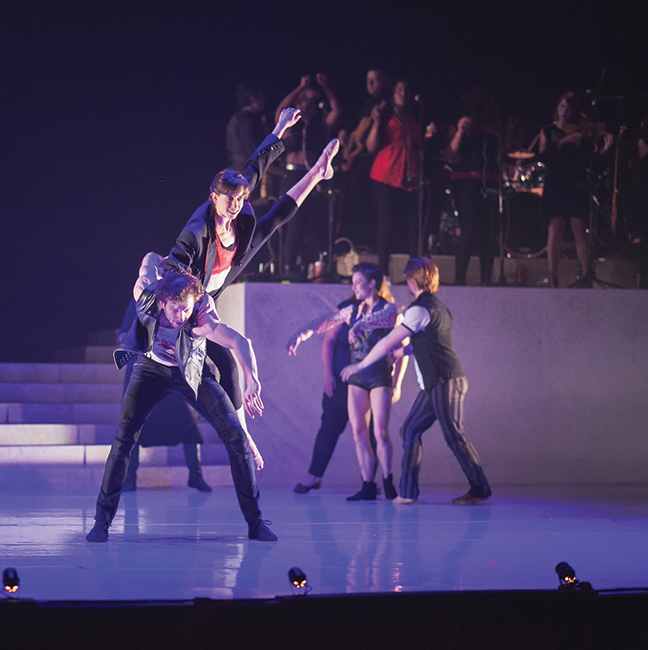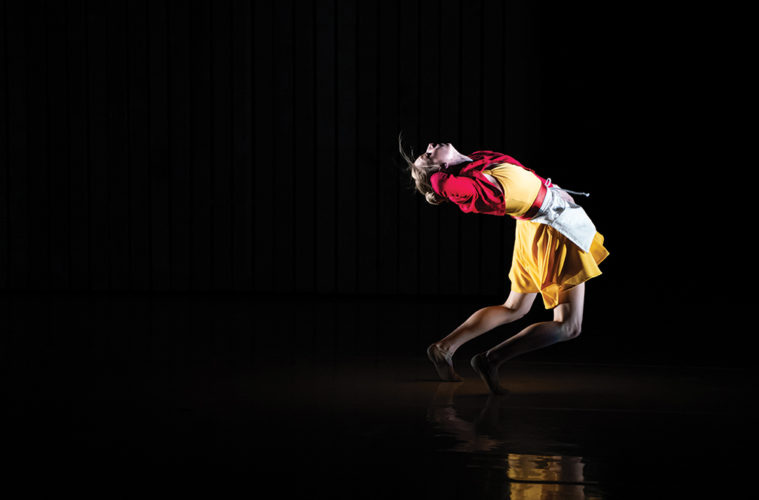BY SHALEEN DESTEFANO
If you haven’t already acquainted yourself with the profound company Wonderbound, we hope this helps you remedy that immediately. Wonderbound is a contemporary ballet company that breaks the rules in the best possible way. From performing with live musicians, to ensuring they share their craft with the outside world through their open door policy, they inspire us. We had the opportunity to talk with Artistic Director and Choreographer Garrett Ammon.
 Wonderbound was introduced to the art and dance scene of Denver eight years ago. Can you give us a glimpse into your backstory?
Wonderbound was introduced to the art and dance scene of Denver eight years ago. Can you give us a glimpse into your backstory?
My wife, Dawn Fay (President of Wonderbound), and I moved to Denver in 2007 to join the organization, which at that time was Ballet Nouveau Colorado in Broomfield. We came on as the new artistic team, we had been dancers/choreographers with Ballet Memphis, and we were excited to take the next step in our careers and become directors, as it was a longtime dream of ours. Promptly after we moved here the economy crashed. We were holding the organization together with our bare hands trying to navigate a world where the floor had fallen out from under us. In the midst of that challenging period, we had a vision and dream of building a dance company and doing it in a different way. We both had broad experience in the dance world with both classical and contemporary work and were actively trying to move forward with our ideas.
The pivotal moment for us to become Wonderbound was when Bonfils-Stanton Foundation came to us and said, “We want to help you figure out how to make this work. You are managing right now, but we see much more potential inside of you than what you’re able to achieve.” They opened the door for us to look at the whole project in an entirely different way, on a financial level as well as an advisory level. It gave us a chance to dream. Over the next many months we disassembled the whole organization and came to the conclusion that we needed to split it into Colorado Conservatory of Dance (CCD) and Wonderbound. CCD is the school, headed by Director Julia Wilkinson Manley. (We were students together at Houston Ballet Academy, so we’ve known each other for our entire adult lives.) Whereas, the professional company became Wonderbound. This was our chance to start over on some level and be able to focus our respective missions to the constituency that we were serving. It was life changing. It was such a rare and significant thing to see in the arts world, for a foundation to make that kind of commitment. It’s hard to describe what a huge impact that made for us.
 Your dance company is, without a doubt, leading the pack with innovative and creative collaborative work. How did you come to the idea to choreograph multi-medium performances with local writers, photographers and musicians, offering transformative experiences that ultimately shatter the idea of how dance can be shared with the community?
Your dance company is, without a doubt, leading the pack with innovative and creative collaborative work. How did you come to the idea to choreograph multi-medium performances with local writers, photographers and musicians, offering transformative experiences that ultimately shatter the idea of how dance can be shared with the community?
When we moved here, we immersed ourselves in the community and discovered such an open and welcoming family in the arts, full of incredible artists doing amazing, daring things that were deeply inspiring. Right from the beginning we were introduced to many organizations. Two of which were with Lighthouse Writers Workshop and Curious Theatre Company – those collaborations launched the beginning of it for us. The Lighthouse Writers show was a collaboration with three poets and three choreographers. At the same time, I ended up choreographing for Curious Theatre Company. It opened up a whole new world of possibility in our creative expression and made us look at our art through a different lens. It was important from the beginning to try and escape ending up in our own bubble, looking at our art form internally and not fully understanding how it’s connecting to the rest of the world. It taught us a lot about what it was we were trying to do and how we were trying to serve our community. It helped us to free our art form of ballet from traditional constraints that can cause it to feel distance from a contemporary audience. We’re deeply proud of the fact that we have carved a path of discovery that is unique to the organization and the community.
We are extremely impressed with your dedication to making dance accessible to a wide audience through your community programs. Can you tell us more about the people and organizations you are impacting?
The organization has a long history and tradition of doing extensive community programs even before we arrived. For me personally, I grew up in a family that didn’t have much means, and it was through nonprofit organizations that I was able to train and become a professional dancer. I know first hand just how important that accessibility can be.
One thing we have always believed is that dance should belong to everyone, not just the fortunate few that have the means to buy a ticket to a show. We have open rehearsals where anyone can come by any day of the week, sit in and watch the creative process. This goes from the beginning steps of creating a show, all the way to when we’re in final rehearsals with the band in the studio. It gives people access to understanding what that creative process looks like, which can be very distant for so many. But for those who don’t have means to go to shows in a more traditional manner, it allows it to be a part of their daily life.
We also make sure we share our art directly with groups of people for whom it wouldn’t necessarily be accessible. When we were at Park Avenue and Broadway, we were located among three of the city’s largest homeless missions. So our daily audience, with our garage open, was the homeless. That was really transformative for us to be able to have that ongoing dialogue and make that reality very permeable. We developed the program Pari Passu which started with the St. Francis Center. It is a weekly dance program led by Registered Dance Movement Therapist Heather Sutton, who hosts a dance session with any of the homeless who would like to join and explore movement as a way of expressing themselves. It’s an incredibly special thing. There have been many people that have been involved for an extensive amount of time, before moving on into traditional housing, getting jobs, and even continuing the program to encourage others. We also started bringing the homeless to our Sunday matinée shows at Pinnacle Charter School. St. Francis provides them a fresh pair of clothes and they get to come see our show as an arts patron and escape their day-to-day for a while and enjoy a show like the rest of the community. It is such a special thing to share. There can be this line where people feel alienated from the rest of the world and then they don’t feel any access points back into society. So we’ve expanded that program to include Colorado Coalition for the Homeless. It’s a wonderful thing that we’ve been able to continue, even after we moved from that location. We now bus them to our new location to have the chance to continue to experience the art.
Our other main focus area is with Title I elementary schools. We are in 35-40 schools every year across Metro Denver. These are the most underserved elementary and junior high school students in our community and don’t have much, if any, arts programming. Many of these kids are living well below the poverty line. We not only share dance with them by showing them excerpts from our programs, but we also directly collaborate with the kids. The dancers work with them to create their own unique dance performances and then we include the entire school. The students get to actively participate as a community in creating together. It’s about teamwork and self-expression, and above all, it’s about empowering these kids to have a new outlet to express themselves – one that they might not have had before.
 In our research of your collaborative projects, we see an array of our favorite local artists, Mark and Kristen Sink, Eric Dallimore, Lighthouse Writers Workshop, and on and on. It is our experience that the Denver art scene is welcoming and supportive. Do you have a favorite collaboration you can tell us about?
In our research of your collaborative projects, we see an array of our favorite local artists, Mark and Kristen Sink, Eric Dallimore, Lighthouse Writers Workshop, and on and on. It is our experience that the Denver art scene is welcoming and supportive. Do you have a favorite collaboration you can tell us about?
Our collaborations with Mark and Kristen Sink have run the gambit; however, I’ve worked with Michael J. Henry of Lighthouse Writers Workshop on four ballets now. Some of our earliest musical collaborations were with Jesse Manley and the band Paper Bird. These early music collaborations really drove us to make the commitment to have all live music in our season performances. Once we started doing these live music collaborations, it was impossible to go back to canned music, because you lose an entire dimension to what you do. We are the only dance company in the country that is committed to doing live music for all performances all season. It has become an integral part of who we are in our identity.
Our next production DIVISIONS, is with Flobots, and we just finished The Sandman with Gasoline Lollipops. We have a long-standing yearly relationship with the Colorado Symphony, and the list goes on and on. It’s always so inspiring and has taken me in directions that I’d never imagined I would have gone before. Part of this has helped me to discover this aspect to work that people love. These narrative realities of creating shows tell surprising stories. We are creating these new fairy tales for a modern audience. From creating Celestial Navigation, a sci-fi b-movie ballet with the Ian Cooke Band, to the show we just finished, The Sandman, which was originally envisioned to be a ballet version of a spaghetti western, but ended up going far beyond the reaches of a western. Each of these collaborations sends us into new territory that the traditional ballet world wouldn’t land on.
What can you tell us about your upcoming show, DIVISIONS with Flobots?
When we started this project, Flobots were in the process of recording their album No Enemies, and we ended up premiering the show in conjunction with the release of the album. The entire creative process happened during the time leading up to the 2016 elections. We were living in a world with a lot of divisiveness and tension across all aspects of our society. One thing that became important to all of us was to not express any specific political or social position, but to embrace the idea that we have to listen to each other. We have to have conversations. We need more empathy in the world. We need to take the time to remember that we are all humans, we are all flawed and we are trying to find our way, regardless of our positions on any given topic. This will ultimately be what helps us journey through such a difficult period. The way that this is expressed in the world ebbs and flows. We are living in a world that is changing fundamentally, and we don’t understand it yet. This makes it more important for us to continue to humanize each other. This is the jumping off point for the show – it’s a message of recognizing and trying to, in some way, rectify the divisions that are inherent in human nature. We are always on a continuing journey to improve ourselves as individuals and communities. When something happens in the world and we see it on social media, we can jump to conclusions about the people involved. But if we can take the time to slow down and look at the intricacies, we can come to understand that there’s a lot more to it that leads people to these outward moments of strife.
What can we expect from Wonderbound in 2020?
We will be announcing our new season at DIVISIONS, it is our tradition to announce our new season at the final production of the year. We are excited about the collection of existing audience favorites and some new exciting and ambitious projects. As we move forward, we reflect on the fact that we have been able to achieve some really significant new things that are deeply inspiring. We are going to continue on that track of pushing the limits and exploring new territory with our existing and new collaborators.
Together with your wife and muse, Dawn Fay, Denver has been gifted an artistic treasure in Wonderbound and for that we are eternally grateful, Garrett.

